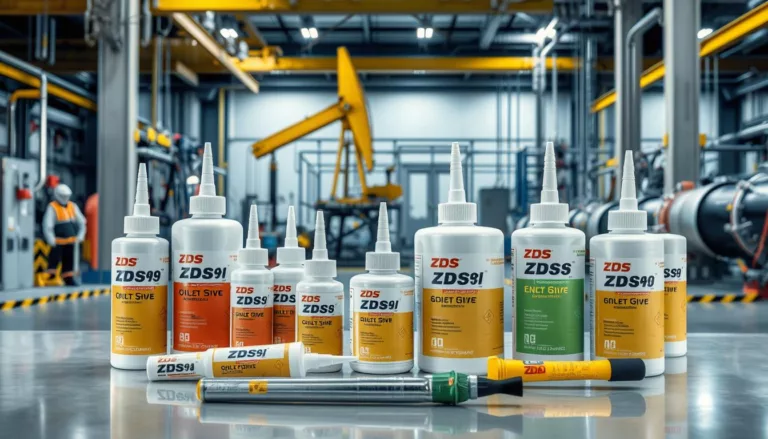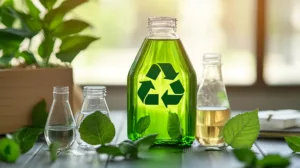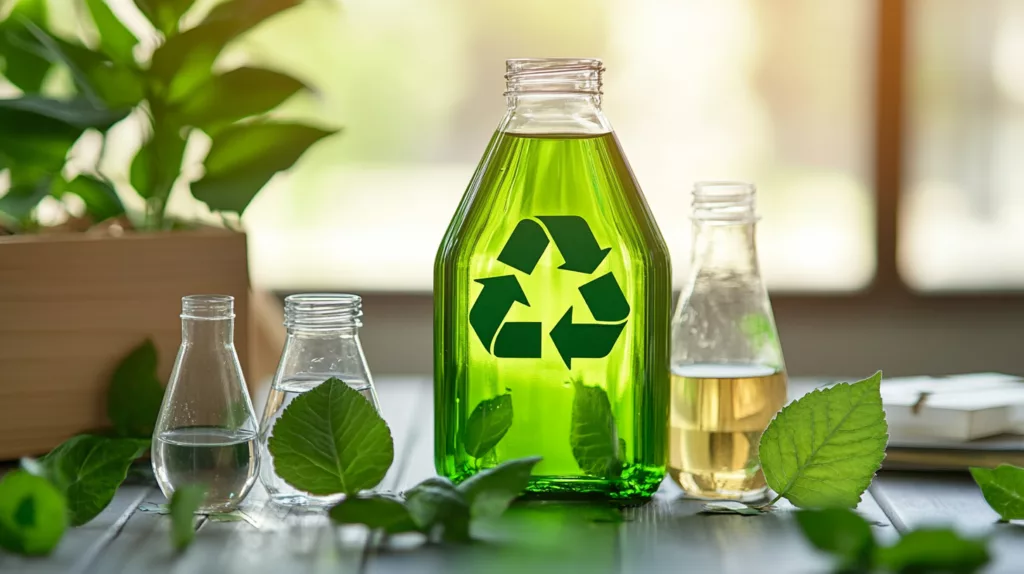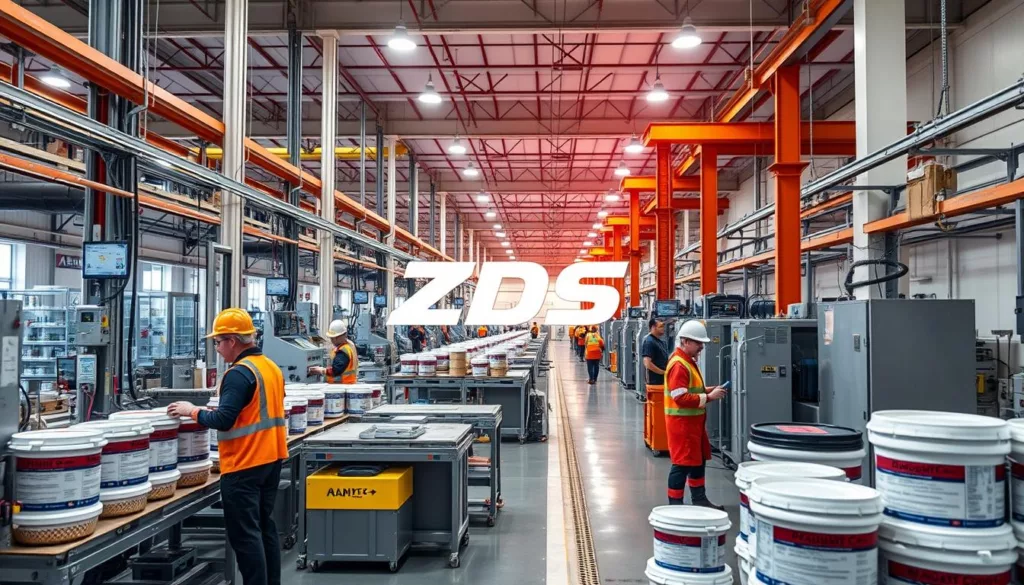Choosing the right adhesives in the oil and gas field is key to keeping things safe and efficient. This guide will show you how to pick the best ones. It focuses on what makes adhesives work best for oil and gas tasks. If you know which adhesives to use, you’ll make better decisions, whether for work or personal projects.
Key Takeaways
- Importance of selecting high-quality industrial adhesives.
- Understanding the unique requirements of the oil and gas sector.
- Factors influencing adhesive performance in extreme conditions.
- Regulatory standards affecting adhesive selection.
- Long-term performance assessment methods for adhesives.
- Emerging trends in adhesive technology and sustainability.
Understanding the Role of Adhesives in the Oil and Gas Sector
In the oil and gas sector, adhesives are very important. They help keep everything running smoothly. These glues are key to making sure parts stick together. This keeps operations safe and reliable.
Importance of Adhesives in Operations
Adhesives make things work better by sticking parts together tightly. They help stop leaks and parts from breaking. Different glues work well even in tough situations. They keep things working right no matter what.
Common Applications in the Industry
Adhesives are used in many ways in the energy sector:
- Pipeline construction, critical for transporting oil and gas safely
- Equipment assembly, ensuring parts are firmly secured
- Maintenance tasks, where reliable sealing is essential to avoid downtime

Adhesives are flexible tools for the energy industry. They’re important in many areas of work. Knowing about these uses helps people pick the best adhesives for their jobs.
Types of Adhesives Used in Oil and Gas
In the oil and gas industry, choosing the right adhesive is key. Each adhesive is unique and fits certain needs. Knowing the differences helps pick the best one for petrochemical uses. In this overview, we’ll look at several top adhesives used in this field and their benefits.
Solvent-Based Adhesives
Solvent-based adhesives bond materials fast and strong. They work quickly, perfect for rapid assembly needs. This feature is especially useful for jobs that need to be done fast in the oil and gas industry.
Epoxy Adhesives
Epoxy adhesives are known for their strong bond and resistance to chemicals. They last long even in tough conditions. This makes them ideal for repairs and building sturdy structures, keeping equipment safe and durable.
Polyurethane Adhesives
Polyurethane adhesives are flexible and tough, great for parts that move. They’re used to make seals and gaskets that hold up under temperature changes, ensuring a secure bond in varying conditions.
Silicone Adhesives
Silicone adhesives handle extreme heat and are very durable. They are perfect for protecting parts outside. These adhesives make sure equipment works well, even when faced with harsh weather or temperatures.
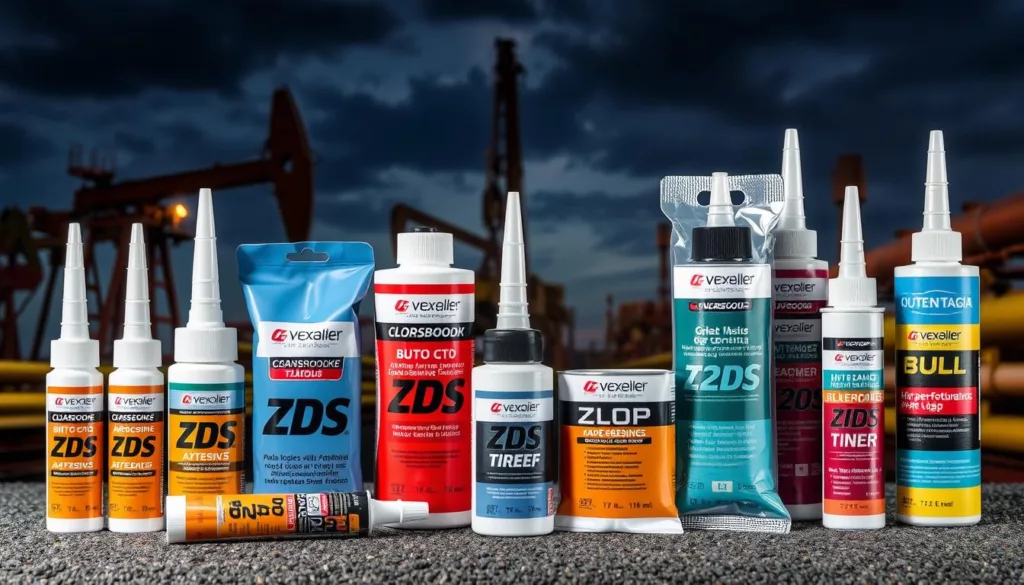
Knowing about different adhesives is important for choosing the right one for petrochemical tasks. Click here to learn more. Each adhesive has its own purpose that can enhance how oil and gas operations run.
| Type of Adhesive | Advantages | Common Applications |
|---|---|---|
| Solvent-Based | Quick application, good initial tack | Assembly processes, general bonding |
| Epoxy | Superior bond strength, excellent chemical resistance | Repairs, structural assemblies |
| Polyurethane | Flexibility, resilient | Gasketing, sealing applications |
| Silicone | High-temperature resistance, weatherproof | Sealing, outdoor applications |
Key Properties to Consider
Choosing the right adhesives for the oil and gas industry is important. The essential properties of adhesives affect how they perform in these settings. Let’s look at important factors like temperature and chemical resistance, along with cure time and how to apply them.
Temperature Resistance
Adhesives need to handle extreme temperatures they meet on the job. High-quality adhesives can withstand these conditions, ensuring they last and work well. Because temperature changes can affect how well things stick together, this is key for keeping operations running smoothly.
Chemical Resistance
Chemical resistance is also critical for adhesives in the oil and gas fields. They have to resist solvents, oils, and other chemicals. Some adhesives are specially made for this industry. They have additives that make them more resistant, ensuring bonds hold for a long time.
Cure Time and Application Methods
The time it takes for adhesives to set, or cure, matters to project schedules. Quick-setting adhesives mean less wait time and more work done. The way you apply adhesives – like spraying or brushing – depends on their type. It’s crucial to choose the adhesive that fits your needs in both these areas for the best outcome.
| Property | Importance | Examples of Suitable Adhesives |
|---|---|---|
| Temperature Resistance | Ensures durability in extremes | High-Temperature Epoxies, Silicone Adhesives |
| Chemical Resistance | Prevents bond degradation | Solvent-Based Adhesives, Polyurethane |
| Cure Time | Affects operational timelines | Fast-Curing Epoxies, Instant Adhesives |
Environmental Factors Affecting Adhesive Performance
Knowing about the environment is key to picking the right adhesive for oil and gas. In this part, we look at important things like pressure, humidity, and chemicals that really affect how well adhesives work.
Pressure Conditions
High pressure can change how adhesives perform, especially their sticking power. It’s important to know the highest pressure they can handle. They need to stay strong under these conditions for reliable use.
Humidity Levels
Humidity is a big deal for how adhesives set. With lots of moisture, bonds might not form well and become weak. Knowing the level of humidity expected is key to choosing the right adhesive for oil and gas tasks.
Exposure to Chemicals
In oil and gas, adhesives often meet tough chemicals. Picking ones that can resist chemicals is crucial to stop them from breaking down and last longer. Knowing the chemicals they’ll face helps in picking the best adhesives.
| Environmental Factor | Impact on Adhesive Performance | Considerations for Selection |
|---|---|---|
| Pressure Conditions | Affects bond strength and integrity | Choose adhesives rated for expected pressure levels |
| Humidity Levels | Can weaken joints if not properly cured | Select adhesives designed for high-humidity environments |
| Exposure to Chemicals | Potential for rapid degradation | Ensure compatibility with anticipated chemical substances |
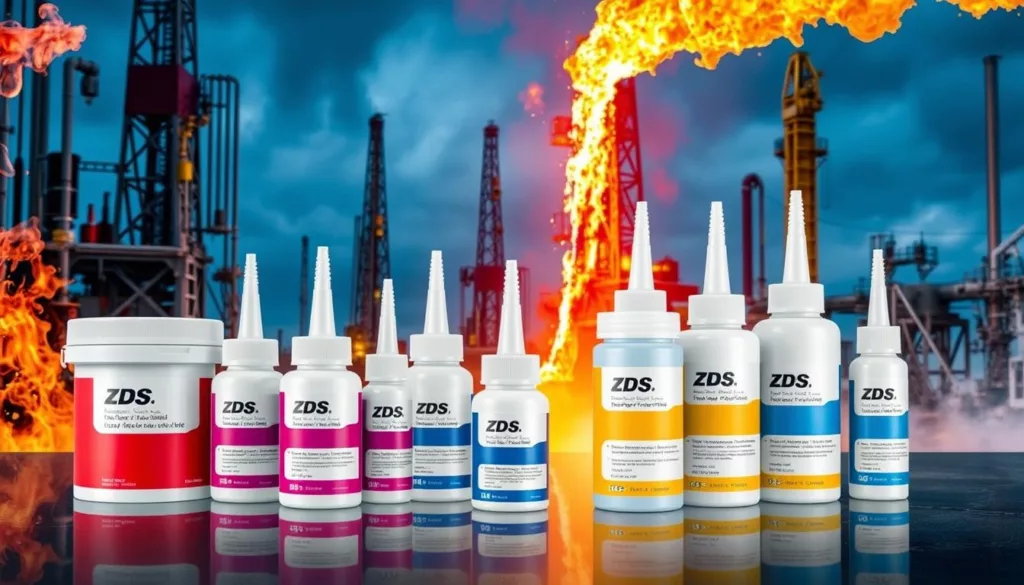
Common Challenges When Choosing Adhesives
Choosing the right adhesives for oil and gas tasks is often tough. It’s important to pick ones that work well with different materials and endure extreme conditions. Knowing these challenges helps in making smart choices and lowers risks.
Compatibility with Different Materials
Finding adhesives that work with many materials in oil and gas is a big task. These materials range from metals to plastics and composites. The adhesive should stick well to these to keep everything together.
Things like the texture of the material, how it’s exposed to the environment, and the adhesive’s chemical makeup matter a lot. You need to test and evaluate carefully to avoid any problems.
Performance Under Extreme Conditions
The oil and gas world often faces tough conditions. This includes:
- High temperatures
- High pressure
- Exposure to harsh chemicals
Adhesives need to be strong and last long in these tough conditions. Checking how well they perform over time is key. This ensures everything runs smoothly and safely.
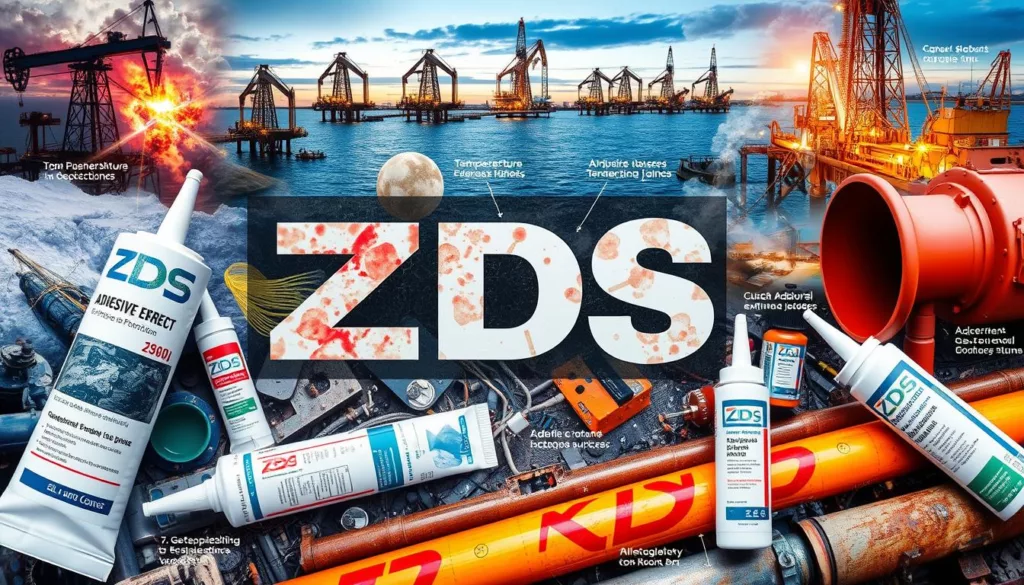
Regulations and Standards in the Industry
The oil and gas sector follows strict rules to ensure safety and protect the environment. It’s important for manufacturers to know these rules for choosing adhesives. The right compliance standards boost the product’s efficiency and market approval.
Overview of Relevant Compliance Standards
Several rules guide the use of adhesives in this industry. Here are the main ones:
- ANSI/ASA—Sets guidelines for adhesive use in different settings.
- ASTM Standards—Defines tests to check if adhesives perform well.
- ISO 9001—Aims at quality management for adhesive makers.
These regulations ensure adhesives can handle tough oil and gas conditions. They also keep safety and performance up to par.
Importance of Certification
Getting adhesive certification for oil and gas is key for manufacturers. It shows their products meet strict requirements after thorough testing. The perks include:
- More trust from clients.
- Better product reliability and performance.
- An edge over competitors.
Understanding certification is crucial as manufacturers deal with complex rules. It helps them strategize their products better.

Manufacturer Reputation and Experience
In the world of industrial adhesives, knowing a manufacturer’s reputation is key. Reliable brands earn trust through years of experience, consistent quality, and positive customer reviews. This evaluation helps ensure the success of adhesive applications in complex oil and gas ventures.
Evaluating Brand Credibility
To pick the right adhesive brands, various steps can help gauge their trustworthiness:
- Researching industry reviews and client testimonials
- Examining certifications from relevant standards organizations
- Considering endorsements from industry partners and experts
- Reviewing case studies that demonstrate successful applications
Such approaches offer a glimpse into the brand’s history of success, assisting professionals in making informed choices. Brands that are well-regarded often perform better under tough conditions.
Importance of Technical Support
Access to technical support is another key consideration when selecting adhesives. Manufacturers with robust support make it easier to overcome application or troubleshooting issues. Available support can include:
- Advice on choosing the right adhesive products
- Training on how to apply them for the best effect
- Solutions for any problems that arise on the job
In conclusion, the reliability of adhesive manufacturers matters greatly for product performance. Thus, looking into brand reputation and available technical support is crucial for making wise decisions and achieving project success.
Testing and Evaluation of Adhesives
Testing and evaluation are key to finding how well adhesives work in the oil and gas industry. We use different methods to check if adhesives can hold up under tough conditions. This includes checking their strength, how they handle heat, and if they can resist chemicals.
By following set testing plans, we can tell how good an adhesive is. This helps us be sure about the performance of adhesives.
Common Testing Methods
We use various tests to look into specific adhesive qualities, including:
- Tensile Testing: This test sees how strong the bond is when pulled.
- Shear Testing: It checks the adhesive’s strength against sliding forces.
- Thermal Cycling: Tests how the adhesive does under different temperatures.
- Durability Testing: Looks at how well adhesives last when exposed to chemicals and the environment.
Assessment of Long-Term Performance
It’s important to know how adhesives hold up over time. Checking their long-term strength shows us what problems might come up. This could be from the environment or the materials getting tired.
Assessments include:
- Putting them in real-life conditions to see how they change.
- Testing their bond strength now and then to catch any issues.
- Noting how their physical and chemical properties shift through time.
Cost Considerations
Choosing the right adhesive for oil and gas projects is key. It’s important to understand cost analysis in adhesive selection. Looking at the big picture of costs is crucial, not just the price you pay first. This way, you make sure the adhesive works well and fits your budget.
Budgeting for Adhesives
Budgeting for adhesives means looking at all costs. This includes:
- Material sourcing costs
- Application techniques and labor
- Potential maintenance and replacement costs
All these factors add to the total cost of using adhesives. Doing a thorough cost analysis in adhesive selection helps predict these costs better.
Balancing Cost with Performance
It’s vital to find a balance between cost and performance. A cheaper adhesive might not be strong or durable enough, leading to more costs later. Look at important features like shear strength and resistance to chemicals. For more help, check out this comprehensive guide.
To sum up, smart budgeting for adhesives isn’t about the initial cost alone. It also means thinking about long-term effects. With careful planning, businesses can choose adhesives that are affordable and meet the oil and gas industry’s needs.
Case Studies: Successful Adhesive Applications
This section explores successful adhesive uses in the oil and gas industry. We look at how these materials boost efficiency and safety. Through specific examples, the importance of adhesives in tough conditions becomes clear.
Example 1: Pipeline Integrity
A leading oil company improved a pipeline’s joint stability with an advanced epoxy adhesive. This adhesive resisted harsh chemicals well. It stopped leaks and extended the pipeline’s life. High-quality adhesives are shown to be key for dependable oil and gas operations. Professionals should pick suppliers wisely, like ZDS epoxy adhesives, offering both performance and customization.
Example 2: Equipment Assembly
In an equipment assembly case, the right adhesive cut down assembly time. It also made the equipment more reliable. A specialized polyurethane adhesive gave strong bonds and resisted vibration. This case shows the power of the right adhesive in oil and gas. It proves choosing the correct adhesive can make processes smoother and safer.
| Project | Adhesive Type | Benefits |
|---|---|---|
| Pipeline Integrity | Epoxy Adhesive | Joint stability, chemical resistance, leak prevention |
| Equipment Assembly | Polyurethane Adhesive | Improved bonding, reduced assembly time, vibration resistance |
Future Trends in Adhesive Technology for Oil and Gas
The future of adhesives in the oil and gas sector is exciting. Groundbreaking strides in adhesive technology are underway. These advances are thanks to material science improvements. They’re bringing adhesives that are stronger, last longer, and can withstand harsh conditions. Such innovations are making adhesives more reliable and efficient for industry challenges.
Innovations in Material Science
Adhesive technology is seeing amazing progress with smart materials. These materials adjust to changes in temperature or chemical exposure. Adhesives that can adapt in this way will greatly improve the durability and safety of oil and gas operations. They’re setting new standards for construction and maintenance in the industry.
Sustainability Initiatives in Adhesive Products
There’s also a strong move towards sustainability in adhesive production. Manufacturers are looking into greener materials and cutting down on harmful emissions. They’re working on making adhesives more recyclable too. This focus on eco-friendly practices is important. It shows a commitment to protecting the planet, meeting new regulations, and fulfilling the expectations of consumers. The path forward for adhesives in this field aims to balance top-notch performance with environmental care.
FAQ
What are the best adhesives for the oil and gas industry?
The top choices in adhesives for oil and gas are epoxy for strong bonds, and polyurethane for its flexibility. Silicone adhesives stand out too, thanks to their high temperature resistance and lasting durability in tough conditions.
How do I select adhesives for petrochemical applications?
To pick the right adhesive for petrochemical uses, you need to know the required chemical and temperature resistance. Also, consider how long it takes to cure in that specific setting.
What properties should I consider when choosing adhesives for oil and gas?
Look at temperature and chemical resistance, along with cure time and how to apply it. It’s vital that the adhesive can handle extreme conditions and harsh chemicals to bond well in oil and gas operations.
What common challenges exist when selecting industrial adhesives?
It’s tricky to match adhesives with different materials, and they must perform under tough conditions like high pressure or moisture. These challenges can influence how strong and reliable the adhesive bond is.
Why are regulations and standards important in adhesive selection for oil and gas?
Adhering to regulations ensures adhesives are safe and effective for oil and gas work. This compliance reduces the risks of the adhesives failing and makes operations more dependable.
How do I evaluate a manufacturer’s reputation when choosing an adhesive?
Look at industry reviews and endorsements to gauge a manufacturer’s reputation. A reputable one offers good documentation and support for their adhesives.
What testing methods are commonly used to assess adhesive performance?
To test adhesives, common methods include checking shear strength, temperature resistance, and how they hold up against chemicals. Assessing their long-term performance is key to knowing their real-world durability.
How do I budget for industrial adhesives while balancing cost and performance?
When planning your adhesive budget, think about both upfront and application costs, plus any future maintenance. Weighing the cost against the benefits helps ensure you get a good deal that doesn’t skimp on quality.
What innovations in adhesive technology should I be aware of for the oil and gas sector?
Keep an eye on new materials and eco-friendly products in the adhesive field. These innovations aim to improve performance while being kinder to the environment.
Can you provide examples of successful adhesive applications in the oil and gas field?
One success story is in pipeline construction, where adhesives add strength to joints. Another is in equipment assembly, helping enhance efficiency and dependability.

